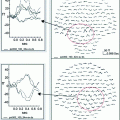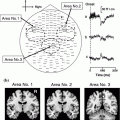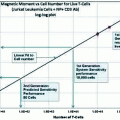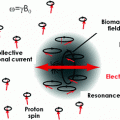Fig. 1
Comparison of mapping with MEG, nTMS and ECoG in a patient with epilepsy, depicted on a 3-D reconstruction of the patient’s brain. Epileptiform region near the motor cortex, as depicted by MEG, is colored yellow. Red dots indicate sites producing motor evoked potentials in nTMS. Green dot indicates the anatomic indicator of the hand motor area. Red circles mark electrodes where stimulation elicited typical seizures, dark blue circle indicates site producing hand movements and a seizure, and light blue circles indicate sites producing hand and arm movements. The surgeon removed the cortical area delineated by black lines. After the operation, the patient has remained free of seizures. Modified from Vitikainen et al. (2009)
In the foreseeable future, TMS devices will develop towards more complex delivery of pulses into multiple sites, monitoring the effects of TMS by electrophysiological measures, and even guiding the TMS properties by the induced modifications. Although simultaneous TMS and MEG recordings probably will not be feasible, MEG will be a crucial tool in interpreting the electrophysiological connectivity utilized in such studies. Combining MEG and nTMS has already proven to be valuable in clinical evaluations (e.g. Vitikainen et al. 2009; Mäkelä et al. 2013, see also Fig. 1). Such combinations will assist us in understanding the complex brain networks, the effective connectivity within them both in the healthy and diseased brains.
References
Airaksinen K, Butorina A, Pekkonen E, Nurminen J, Taulu S, Ahonen A, Schnitzler A, Mäkelä JP (2012) Somatomotor mu rhythm amplitude correlates with rigidity during deep brain stimulation in Parkinsonian patients. Clin Neurophysiol 123:2010–2017CrossRef
Barth DS, Sutherling W, Engel J Jr, Beatty J (1982) Neuromagnetic localization of epileptiform spike activity in the human brain. Science 218:891–894CrossRef
Brier MR, Thomas JB, Snyder AZ, Benzinger TL, Zhang D, Raichle ME, Holltzman DM, Morris JC, Ances BM (2012) Loss of intranetwork and internetwork resting state functional connections with Alzheimer disease progression. J Neurosci 32:8890–8899CrossRef
Delbeuck X, van der Linden M, Collette F (2003) Alzheimer’s disease as disconnection syndrome? Neuropsychol Rev 13:79–91
Stay updated, free articles. Join our Telegram channel

Full access? Get Clinical Tree







